As the largest and best-preserved ancient royal building complex in the world, the Palace Museum is a reflection of the highest architecture level in ancient China.
Forbidden City, located in the center of Beijing, is the largest, best-preserved in the world. The Forbidden City used to be the imperial palace of Ming Dynasty which began to be built in 1406 AD and completed in 1420 AD with toilsome work of tens of thousands of laborers. The rectangle-shaped palace is 961 meters from south to north and 753 meters from west to east. It covers an area of 725,000 square meters and the building area is 155,000 square meters with 8,707 rooms. The wall of palace is 12 meters high and 3,400 meters long. There is a moat with the length of 52 meters around the palace. In this way, the palace becomes a strong and impregnable castle. The building complex was laid out very precisely in accordance with a feudal code of architectural hierarchy which designated specific feature for reflecting the paramount authority and status of the emperor.
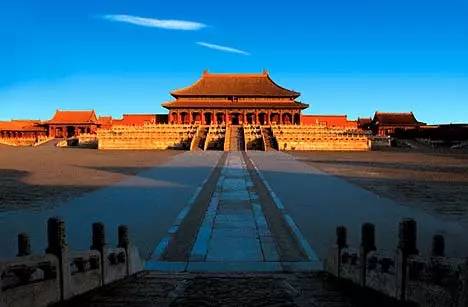
There are four gates to enter the palace, respectively named Wu Gate in the south, the main entrance, Donghua Gate in the east, Xihua Gate in the west and Shenwu Gate in the north.. The Wu Gate has five arches and the middle arch was specially constructed for the emperor. This is also the central axis of the palace and Beijing City. In the past, even though you are the high-ranking government official, you are only allowed to go across the side arch to enter the palace. Construction of the National Palace on the basis of its layout and function is divided into the exterior and interior imperial court.
Centering round Hall of Supreme Harmony, Hall of Central Harmony and Hall of Preserving Harmony, the exterior is the place where feudal rulers exercised their power and held festivals and rituals. The interior court includes Palace of Heavenly Purity, Hall of Union, Palace of Earthly Tranquility, Hall of Mental Cultivation, etc. It's the place where the emperor and his family lived.
In 1911 the last feudal dynasty, the Qing, fell to the republic revolutionaries. The last emperor, continued to live in the palace after his abdication until expelled in 1924. On October 10, 1925, the Forbidden City became the Palace Museum and was opened to the public. Many parts of the palace were destroyed by the war, age and bad weather. After the establishment of People's Republic of China, the palace has been renovated in large scale by the government since 1950s. In 1961, the Palace Museum was designated national key cultural relics under state protection. In 1987, the Palace Museum was selected on the World Heritage List.
The Chinese Great Wall is the great construction in the history of human civilization. It was praised as the Eighth Wonder of the World many years ago. The construction of the Great Wall began during the Spring and Autumn Period to the Warring Period (770BC-221BC). After unification of China by Qinshihuang (the first emperor in China), Qinshihuang ordered his people to build a new wall on the base of the original one in large scale. Subsequent dynasties continued to strengthen and extend the wall. The most part of the extant wall from Shanhaiguan in Pohai to Jiayuguan in Gansu Province were built by Ming dynasty (1386 – 1644AC). The Great Wall is 7.8 meters high, 6.5 meters across at its base and 5.8 meters at its top. There is a watchtower rise to about 12 meters every one hundred meters.

Dating back to the Spring and Autumn Period, more walls were put up to defend the borders of the different kingdoms and nomad nationalities in the northern China. The Great Wall had become the dominant fortification for Han people since Qin Dynasty. In fact, the walls didn't resist the attacks of the dangerous enemies. Ming Dynasty tried their best to renovate the wall, regardless of the expense to humans in effort, time and financial well-being, but ironically, the leader of Qirat not only led his army to crack the defense of the wall, but also took the emperor Yingzong of Ming Dynasty alive in 1499AC. At any rate, the Great Wall is just a wall which cannot protect a nation. Interestingly, the most prosperous Tang Dynasty was one of dynasties which never renovated the wall.
The Great Wall is the symbol of the Chinese civilization. It is the fruit of the Chinese nation's wisdom. Now, the Great Wall is the famous scenic spot attracting tens of thousands of tourists. There is a well-known Chinese saying on the wall, "He who has never been to the Great Wall is not a true man". The Great Wall was selected on the list of the World Heritage in 1987.
Temple of Heaven is located in the southeast of Beijing and existed for more than 500 years. Temple of Heaven was built for emperors of Ming and Qing dynasties to worship the heaven. Temple of Heave is the largest and best-preserved architectural complex for sacrifice in China.
Occupying an area of 2,720,000 square meters, the Temple of Heaven is slightly larger than the Forbidden City. There are two layers of walls around the Temple, dividing it into two parts: the inner enclosure and outer enclosure. The main buildings of the Temple include Hall of Prayer for Good Harvests, Imperial Heavenly Vault and Circular Mound Altar. The Hall of Prayer for Good Harvest has three concentric circles of massive wood columns symbolizing the four seasons, 12 months and 12 daily hours. The Imperial Vault of Heaven is a smaller circular building constructed without crossbeams; its dome is supported by complicated span work. The Circular Mound Altar is a triple-tiered white stone terrace enclosed by two sets of walls that are square outside and round inside, which are symbolic of the square earth and round heaven. Emperors of Ming and Qing dynasties held their ceremonies to worship the heaven in the Circular Mound Altar on winter solstice. Therefore the Circular Mound Altar also called "Heaven Worship Altar".
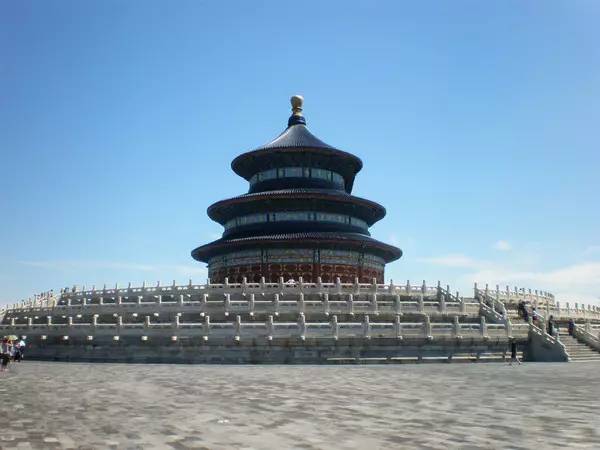
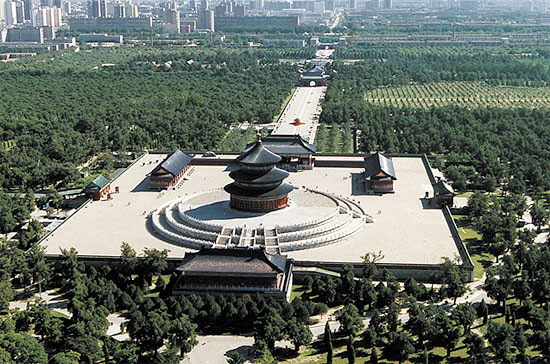
The whole construction of the Temple of Heaven is made by wood so it is the architectural masterpiece of wood construction in China. Another marvelous and magnificent spot of the temple is Echo Wall. When standing in the center of the Circular Mound Altar, you can hear the bright sound which seems to come from the earth's core and sometimes from the sky.
The design ideology of the Temple of Heaven manifests broad and vast sky. As for the aspect of distribution of building, the inner enclosure is situated on the east of north-south axis of outer enclosure; the Circular Mound Altar and Hall of Prayer for Good Harvests is located on the east of the axis of the inner enclosure. This layout makes the west part of the Temple wider.
As the largest building complex for worshiping heaven in the world, the Temple of Heaven was inscribed on the list of the World Cultural Heritage in 1998.
Hutongs, a type of narrow alleys or street, is very typical and unique in Beijing. With the history of 700 years, Hutongs in Beijing display the aspect of Chinese cultural history. At first glance, Hutongs is seemed to have the similar appearances with grey walls and grey tiled buildings. However, if you are patient to talk with the dwellers in Hutongs, you will find that every hutong has its own anecdote and allusion.
Hutong was not only the backbone of transportation in the ancient Beijing but also the place where common people lived. Hutongs represent the vicissitude of society and are rich in cultural atmosphere, which makes hutongs like a folk museum.
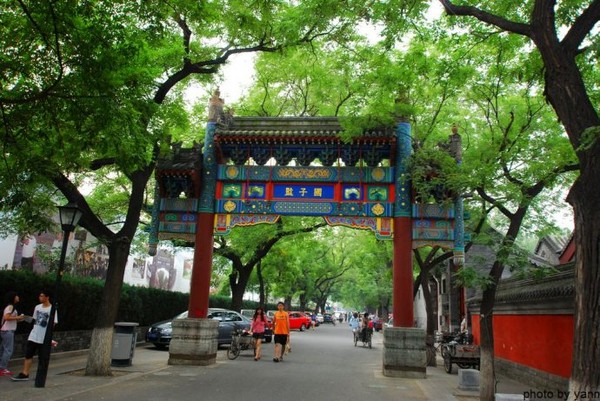
The term 'Hutong' first appeared during Yuan Dynasty (1206AD-1370AD) with the meaning of 'town'. The place which was closer to Forbidden City was lived by those who had the higher social status like high-ranking officials and wealthy merchants. Their houses were called siheyuan which was characterized by carved and painted roof beams and beautiful gardens. And Hutongs were built and lined by the siheyuan and walled gardens.
In the mid-20th century, many hutongs were demolished to pave the way for new buildings and roads. Some of them still stands and have been designated as the protected area.
Some famous hutongs are listed below:
Yandai Xiejie
It is said that Yandai Xiejie is the oldest and most famous Hutong in Beijing. It is 232 meters long and located in front of Drum Tower. In Qing Dynasty, the shops in this hutong operated the business of tobaccos, smoking sets and curios. 'Yan' in Chinese means tobacco and 'Dan' pouch. Yandai is a pouch to contain tobaccos. And some persons said that the shape of street look like a smoking pipe.
During 1950s many buildings were converted into residential houses and this street was redeveloped to contain its historical features in 2007. You can find various types of shops and stores of Indian cloths, Tibet costumes, Lijing crafts, Shaanxi pottery and so on.
Ya'er Hutong
Ya'er Hutong started from Xiao Shibei Hutong in the southwest and is connected with Yandai Xiejie. In the east end stands a famous stone bridge named Xinding Bridge. With the length of 820 meters, it winds along the north bank of Shicha Lake and parallels with north part of Houhai Lake. Guanghua Temple is located at No.31 of Ya'er Hutong. It was constructed during the reign of Emperor Wanli of Ming Dynasty (1368AD-1644AD). It is one of best-preserve temples in Beijing and still in use. Some important Buddhism activities are held here.
Jinsi Hutong
The No.12 of Da Jinsi Hutong has a special arch which was wrote in the book of Lonely Planet and best-known to many tourists. It is said that this siheyuan is the only place which can be lived by foreign tourists.
Fragrant Hills Park also called Xiangshan Park is situated in the northwest of Beijing city, about 20 kilometers away from downtown. With an area of 1,600,000 square meters, Fragrant Hills Park is famous for its imperial garden style and abundance of precious cultural and historical relics.
In fact, Fragrant Hills Park used to be a royal garden in Chinese history. In Jin Dynasty, Emperor Shizong order to build the temple on Fragrant Hills named Grand Yong'an Temple which was now called Xiangshan Temple. During the rule of Emperor Zhangzong of Jin Dynasty, Huijinglou and Jixing Altar were constructed on the hill. In 1795, the government of Qing Dynasty carried on the large-scale constructions on hills by investing the tremendous human and other resource over years.
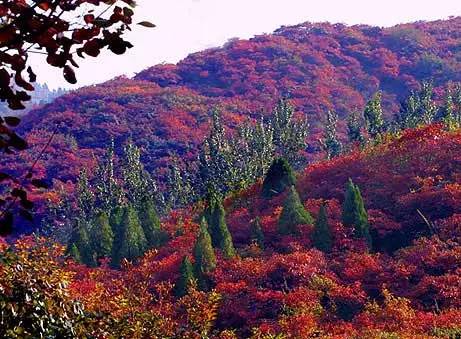
Rising 557 meters above the sea level, the name of Fragrant Hill not derives from the fresh air or aroma in the area but the hills themselves. A biggest stone lies on its peak and looks like an incense burner from the distance. Especially, during the morning or twilight, the stone is shrouded in mist and cloud. It looks as if the mist and cloud curl up from the incense burner. So the hill is named Xianglushan Hill and shorted for Xiangshan Hill (Fragrant Hill).
When mentioning Fragrant Hill, visitors are always impressed by the red leaves of Common Smoketree. The red leaves of Common Smoketree are the most charming autumn scenery in Beijing. Therefore, the autumn is the best time to visit Xiangshan Hills. The red leaves of Common Smoketrees of all over the hill look like the blood. After frost, the red turns purple-red. These trees were planted during the rule of Emperor Qianlong of Qing Dynasty. Now, the number of Common Smoketrees reaches 940,000 and become Common Smoketrees forest.
Inside of the park, you can see Luminous Temple and Jianxinzhai. Luminous Temple is Tibetan-style monastery which set up in 1780 for receiving Penchen Lama. The most striking building in the temple is Octagonal Glazed Tile Pagoda which is 30 meters high. There are 8 bells hanging on its 8 eaves.
Going north from Luminous Temple, we can see a wall and inside the wall is Jianxizhai which is the only best-preserved historical site in the Fragrant Hills Park. Jianxinzhai was constructed in 1522 and rebuilt in 1796. The construction is featured with southern style courtyard.
In different season, Fragrant Hills Park takes on different view. If you plan to visit Beijing, the Fragrant Hills Park is a must-see place.
The Summer Palace situated in the northwestern outskirt of Beijing, about 15 kilometers away from the downtown area of Beijing. As one of the Four Most Gardens of China, the Summer Palace is a grandest integral imperial garden, therefore, it is praised as the "Royal Garden Museum". This former imperial garden with an area of 12,900,000 square meters contains about 3000 hills, palaces and gardens. The construction of the Summer Palace once called Qinqyiyuan (Garden of Clear Ripples) began in 1750 and completed in 1764.
In 1860, the Anglo-French Allied troupes destroyed the Qingyiyuan. In 1888, the Empress Dowager Cixi misappropriated the navy funds about 1.5 millions kilogram of silver to rebuild the garden and renamed it the Summer Palace. In 1900, the Summer Palace was destroyed by the Anglo-French Allied force again and many building were completely burnt out. In 1903, the garden was renovated. However, it was once again destroyed in successive years of tangled warfare among warlords.
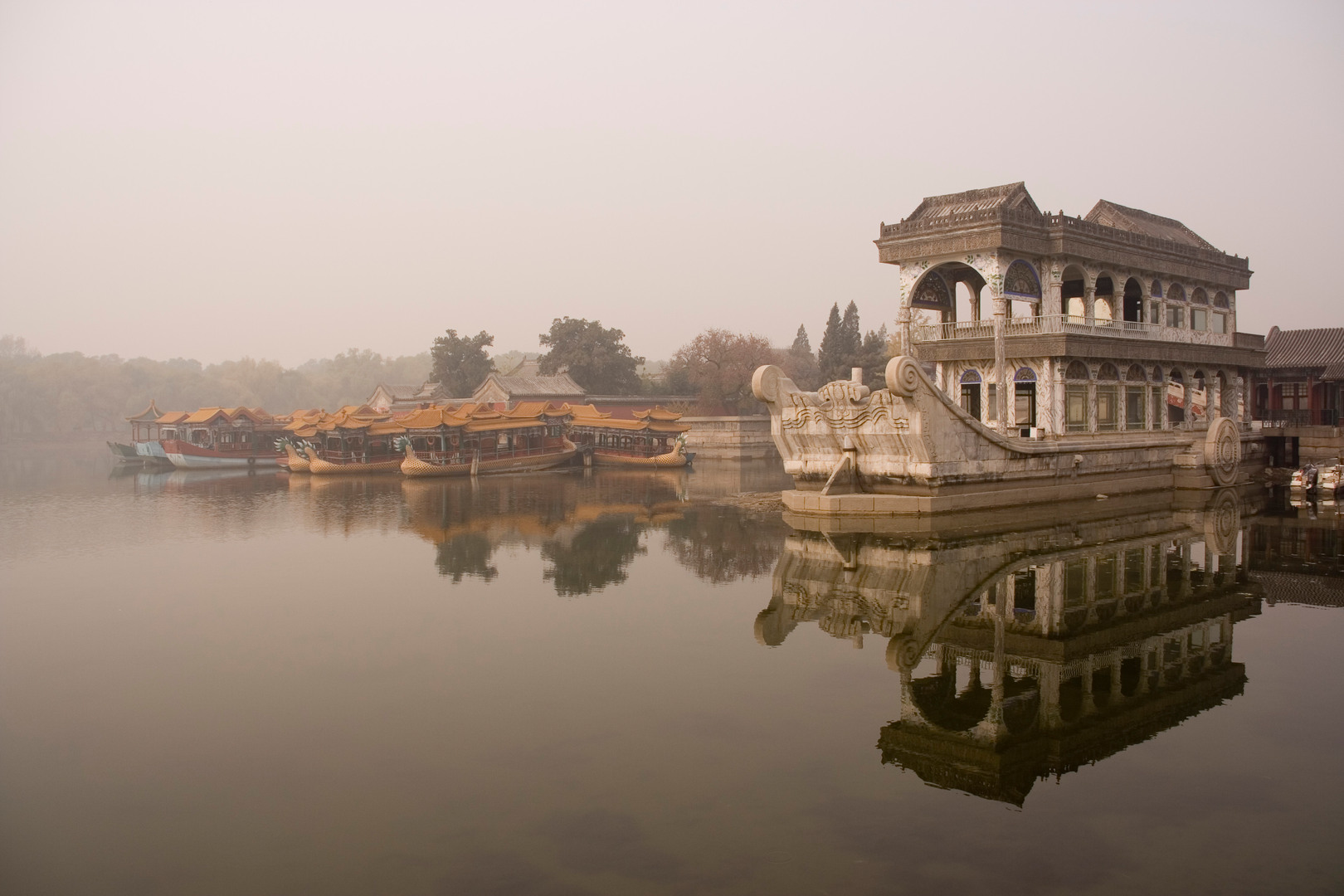
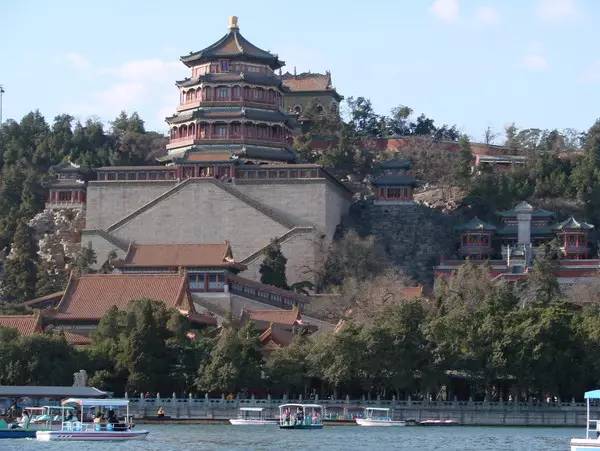
The Summer Palace, dominated mainly by Longevity Hill and Kunming Lake, drew on the Chinese traditional arts of garden construction and borrowed the view of natural mountains and water landscape. In this way, it seems that the garden was created by nature rather than by human. The golden glory of pavilions and halls, the rich verdure of hills and rippling water of lake combine to engender the feeling in visitors that they are walking in the heaven. So the Summer Palace is definitely a gem of the traditional Chinese art of garden construction. Centering on the Pavilion of the Fragrance of Buddha, the garden includes hundreds of building, about 20 courtyards, and 3,555 ancient constructions among which the Long Corridor, Stone Boat, Suzhou Street and Garden of Harmonious Interests are best-known to all. Many kinds of old and precious trees and flowers grow in the garden.
The Summer Palace can be separated into three parts, political activities zone, the living zone and the entertaining zone. The political zone, led by Hall of Benevolence and Longevity, is the venue for major political and diplomatic affairs. The living zone, represented by Hall of Happiness and Longevity, is the place where the Empress Dowager Cixi, Emperor Guangxu and his imperial concubines lived. The entertaining area is comprised of the place along the Long Corridor, and west area.
In 1961, the Summer Palace became one of national key cultural preservation centers. In 1998, it was selected on the World Heritage List. In 2007, it was approved as the 5A tourist attraction.
Lama Temple, also called Yonghe Palace, is the largest and best preserved lamasery in Beijing. Constructed in 1964, it once was the residence of Emperor Yongzheng (the third emperor of Qing dynasty). After the death of Emperor Yongzheng, it was converted into lamasery in 1744 and so Yonghe Palace became the national center of Lama administration.
Occupied an area of 66,400 square meter, Lama Temple is comprised of torii, Grand Hall, Yongyou Hall, Falun Hall and Hall of Boundless Happiness. It is dotted with screen wall with carved murals and decorated archways. The interior pavement leads to the main halls. The evergreen pine and cypress add the peaceful and secluded atmosphere. The Yonghe Palace with the distinctive ethnic characteristics of Manchuria, Han, Mongolia and Tibet has the highest rank in China.
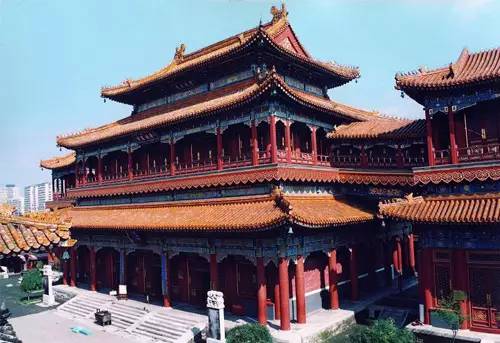
The following details describe the main building inside Lama Temple.
At the south courtyard stand three high monuments, a huge screen wall and two stone lions. Passed through monuments, a pavement leads you to Zhaotai Gate (the gate of Lama Palace) in the north. Inside the gate stand Bell Tower and Drum Tower on both sides. A huge copper pan by the side of Drum Tower weighs 8 tons which was used to cook La Ba Congee (eaten on the eightn day of the twelfth lunar month). To the north is an octagonal tablet which describes the history of Lama Temple.
Grand Hall once was the place which was used to receive civil and military officials. In the north of the hall shrine three 2-meter-high sculptures of Buddha. They are Sakyamuni, Medicine Guru Buddha and Amita Buddha. North of Grand Hall is Yongyou Hall which is the location for lamas for reading ures and holding Buddhist ceremonies. In the center of the hall is a Buddha which was carved out of sandalwood.
In center of Falun Hall is a Buddha with the height of 6.1 meters which is the founder of Tibetan Buddhism, Tsongkhapa. This bronze statue was completed in 1924 and cost 200,000 silver dollars. Behind the Tsongkhapa is an Arhat Hill containing 500 Arhats all elaborately carved out of padauk.
There is another spectacular in Hall of Boundless Happiness, i.e. the sculpture of Maitreya that is 18 meter high and about 8 meters is below the ground.
Now the Lama Palace is an important heritage site under state protection.
Yuanmingyuan Park, situated in the northwest of Beijing, is the most magnificent royal garden of Qing Dynasty in the Chinese history. The construction started in 1709 during the rule of the Emperor of Kangxi (the second emperor of the Qing Dynasty.), went through 6 emperors and finally finished in 1875. The park is comprised of the Eternal Spring Garden, the Wanchun Garden and Yuanmingyuan Garden with the building area of over 160,000 square meters as big as the Imperial Palace and the area of water as large as the Summer Palace.

Yuanmingyuan Park was named by Emperor Kangxi. "Yuanming" means round and brightness in Chinese and the Chinese character is "圆明". The implication of "Yuan" is moderate and the "Ming" means that the brightness can cover the whole nation. Yuanmingyuan drew on the characteristics of Suzhou gardens and inherited the cream of Chinese ancient gardening. The southern part of Yuanmingyuan Park is the place where the emperor handled the national affairs. And the rest part distributes forty scenic areas in which more than 50 spots imitate famous parks, lakes and mountains at home and abroad. Yuanmingyuan was also like an art museum which collected numerous curios and art works. Yuanmingyuan Park was the home of various sorts of exotic flowers and unusual trees. No wonder that Yuanmingyuan Park was reputed "the most beautiful garden in the world".
Unfortunately, this grand royal garden fell into ruins during the Second Opium War. British and French troops ruthlessly invaded Beijing in 1860. On October 6, the Yuanmingyuan was seized by British and French army. On the following day, the invaders began their crazy robbery and destruction. After robbing of everything in the park, Earl of Elgin ordered to set fire to the Yuanmingyan Park for covering up their guilt. After three days burning, the park was turned from a beauty into a deserted place.
After the establishment of People Republic of China, the central government attached much importance to the protection of Yuanmingyuan Park. In 1979, Yuanmingyuan became one of the national key cultural preservation centers. The restoration of the park had been gradually carried out after 1979. Now, Yuanmingyuan has been developed into memorial park.
Ming Dynasty Tombs is located at the foot of Tianshou Mountain of Changping County, about 50 kilometers away from Beijing. Covering an area of over 124 square kilometers, Ming Tombs is a cluster of tombs where the thirteen emperors of Ming Dynasty were buried. The site of Ming Tombs was chosen by Emperor Yongle, the third emperor of Ming Dynasty who moved his capital to Beijin and began to build imperial mausoleum in 1409.
The Ming Tombs is in a small basin which is surrounded by hill on three sides. The site of Ming Tombs was strictly chosen according to Fengshui (geomancy) principles. According to these, evil winds descending from the North must be deflected; therefore, an arc-shaped area at the foot of Jundu Mountains north of Beijing was selected.
Every emperor's tomb was constructed at the foot of a hill and every two tombs are at least 500 meters apart. Except Siling Mausoleum locating in the northwest, the rest twelve tombs were constructed at the right or left of Siling Mausoleum. Designers of Ming Tombs attached importance to the harmony and unity of nature and human being.
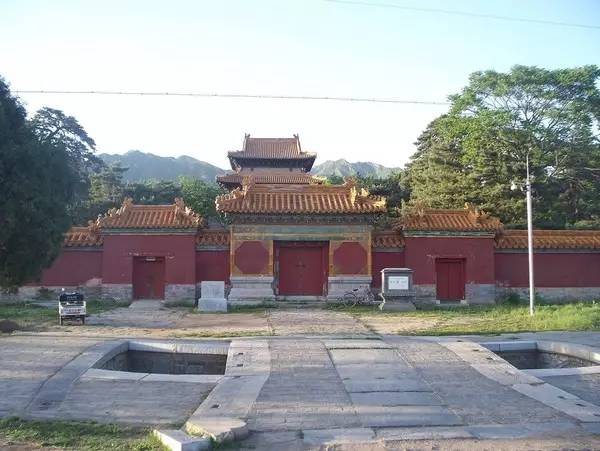
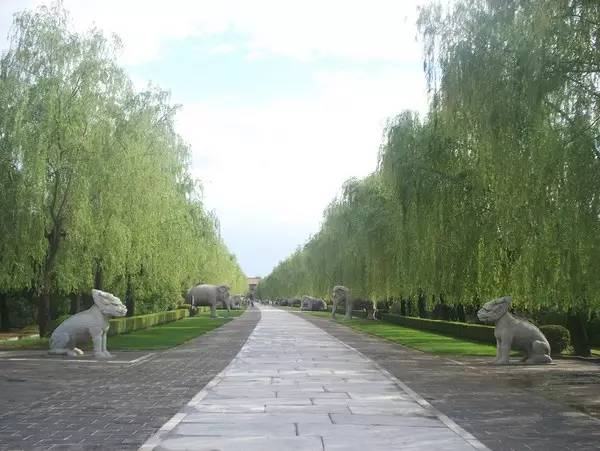
These thirteen tombs share one way called Sacred Way. The Sacred Way is composed of Stone Arch, Big Red Door, Beilou,etc. Entering into the area, visitors can see Stone Arch constructed with white marble in 1540. The Stone Arch was carved with the delicate images of dragon, lion and cloud. Big Red Door is situated at the due south of the area of Ming Tombs. There once were two stelas carved with words like "officials must get off the horse and walk into". The road behind the Big Red Door is Sacred Way leading to Changling Mausoleum. Changling Mausoleum is a joint burial tomb of Emperor Yongle and his queen. Changling Mausoleum is the first and best preserved tomb compared with the rest ones.
Dingling Mausoleum is the only tomb which has been unearthed. Dingling Mausoleum is the tomb of Emperor Wanli, which was constructed from 1584 to 1590. Occupying an area 180 thousand square meters, Dingling Mausoleum takes the shape of round at the front part and square at the back part of mausoleum. The shape of Dingling Mausoleum symbolizes the Chinese ancient philosophical idea, i.e. the Earth was square and Heaven was round.